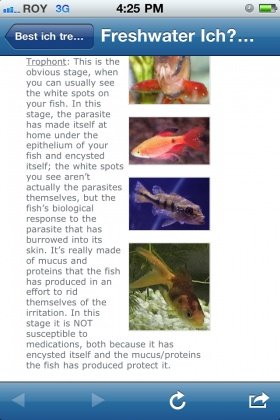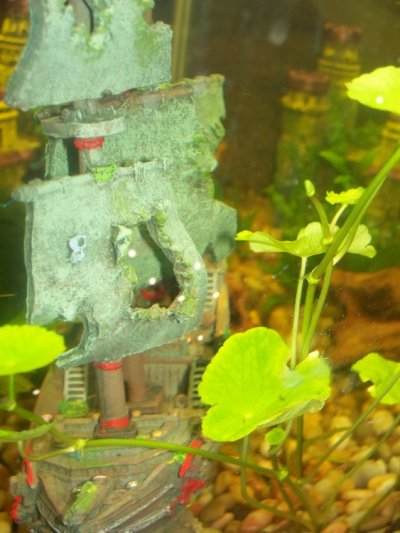Read these articles, read the linked articles/documents in their links, the Skeptical Aquarist has some especially good links.
"Knowledge is Power" & "Know thy Enemy", read, read, read, read, read...
SkepticalAquarist article
AquariumAdvice article
Cichlid-Forum article
Lets dispel a common
'Fish Myth' right off the bat...
ICH is NOT always present in the water/fish...
It is not airborne, it doesn't travel by Spores, it will not come in via tap-water during a PWC and it does not lay dormant.
It must be introduced in some way as noted below.
If you follow through on the
'Heat & Salt Treatment' as specified, I practically guarantee the 100% eradication of ICH within your tank...
Unless you re-introduce it thru lack of quarantine/preventative treatment with new fish, unquarantined/untreated transfers of plants, decor, water or by cross contamination thru the use of equipment in multiple tanks.
'Heat & Salt', either of these treatments alone can/will kill the ICH protozoa, together they eradicate ICH very effectively and completely.
This treatment is especially safe with Oscars as they are very tolerant of both heat & salt.
Please be aware that some fish, inverts and plants may not handle heat or salt well and treatment may need to be adjusted to fit their needs.
Temperature:
Raise it slowly, but ASAP, to at least 86'f, preferably 87'-88'f.
One degree (1'f) every twelve (12) hours is the normally recommended interval for increasing heat, but in a emergency like ICH I'd raise as much as one degree (1'f)every six (6) hours.
Duration:
Hold temp for at least two weeks after the last sign of ICH.
Oxygenate:
This is extremely important because water holds less O2 at higher temperatures.
Filter outflow splash, spraybar or powerhead flow directed at surface, airstone/bubblewands are good ways to increase surface agitation.
Salt:
Salt is not required, but it is IMHO very helpful and I recommend the combination of Heat & Salt.
I recommend continuing the 'Salt treatment' for the duration of the 'Heat treatment'.
Use at your discretion.
Be aware that some Cats/Plecos (in particular Corydoras), Tetras, Loaches and etc, can have adverse reactions to salt.
Fishes that navigate by electric fields, like Elephant Noses, Knifefish, certain Eels should never be exposed to salt.
Many plants are intolerant-highly intolerant of salt.
Quote:
By raising salt levels to 2-3 ppt or 1.002-1.003 specific gravity above what one normally keeps the tank at can destroy the Ich parasites. It has a strong effect on osmosis, and dehydrates the parasite to the point the parasite can no longer function and dies. Again, raising levels slowly but not too slowly is key here; raising salt 1 ppt per day is recommended. Generally 7.6 grams of salt per gallon is equal to 2 ppt or 1.002-1.003 specific gravity . However, it?s the chloride ions which are necessary for the treatment, and different salts have different levels of chloride. It?s best to purchase a hydrometer which measures low levels of salt to ensure proper dosage.
2 weeks at those levels sure eradicate all the parasites. Again, be sure all the fish in your tank can deal with those levels of salt. On that note, most scaleless fish CAN handle these levels of salt. Plecos and Loaches especially do fine despite Internet rumors to the contrary. It has been noted some tetras and Cory's do not do well with salt, however.
Quote:
Based on everything that I’ve read to date, I would feel comfortable adding 2-3 tablespoons salt per 5 gallons if I were also using the high temperature treatment outlined above. If I were using salt alone, I would work my way up to 4-5 tablespoons per 5 gallons. We don’t want to skimp on our treatment if we hope to permanently eliminate this pest. Salt should be added slowly over the course of 24-48 hours or so (always dissolve in a small container of tank water first). Keep a close eye on your fish and perform an immediate water change if they show any additional signs of stress (beyond what the Ich is already causing).
For detailed info about salt check this out,
SkepticalAquarist- Salt
Here are the conversions/measurements for dosing salt from a reliable source, see page four (4), table 3, units in parentheses.
conversions/measurements
Note; you may want to adjust your dosage +/- as desired.
Water Changes/Vacuuming SubstrateWater changes are very helpful in fighting ICH infestations.
Using a gravel vacuum, do a large water change and thorough vacuuming water on a daily basis.
This eliminates a great number of trophozoites and tomites from the water/substrate.
Other ways to combat ICH
A UVS, Ultraviolet sterilizer when properly setup will kill free-floating ICH.
A Diatom filter will capture and kill ICH too.
Micron filtration depending on the size may perform as Diatom does.
Medications:
I would only recommend the use of standard* medications as a last resort, and used in conjunction with the heat treatment at slightly lower temps, 80'-82'F, these temps will greatly speed up the life-cycle and shorten the time needed to medicate successfully.
IMO this is the last resort, a truly desperate measure for a ICH infestation gone unchecked...
I cannot recommend any of the standard* meds, use at your own risk.
Their effectiveness when used as directed is controversial, despite manufactures claims some still seem to affect a tanks bio-filter and many fish-keepers report undue stress related complications.
Many ICH meds will adversely affect/kill scaleless fishes and inverts.
Many ICH meds will also further deplete oxygen levels, take countermeasures as per above.
*A non standard med,
ICH-Attack.
ICH-Attack is a 100% natural remedy that has proven anti-protozoal and anti-fungal properties.
Active ingredient is Naphtoquinone which is not known to be carcinogenic as many standard meds are.
Manufactured by Kordon, available at various retailers.
DrsFosterSmith
If you use standard meds the read this...
Quote:
Do a water change prior to starting treatment and remove the carbon from the filter media; not the entire filter. If the carbon is part of the filter cartridge, make a slit in the side of the filter media and remove the carbon.
Be aware meds will most likely destroy the nitrifying bacterial colonies. Be prepared to measure ammonia and nitrite levels, and reduce the levels if necessary, by water changes or ammonia/nitrite reducers (this is the only time you?ll see me recommend their use!). Water changes likely will affect levels of meds in the tank, and you may need to adjust doses to keep the meds at the levels needed to kill the theronts.
Once treatment is finished, you?ll need to remove the meds from the water. Best way to do this is to run fresh activated carbon in your filter for a couple of days.
** Do note, the directions on the meds are generic; if you remember from the earlier discussion ich has a life cycle with only one stage susceptible to meds. Do not follow the directions when it comes to length of dosing times as some will claim to eradicate Ich in as little as one dose. The first treatment will only kill a percentage of the parasites (remember the Ich life cycle). It?s better to continue treatment till 3 days after seeing the last white spot on your fish; this way you can be fairly sure you have eradicated all the parasites.
AquariumAdvice article
Please realize that ICH like everything else in the world has it's exceptions, however rare.
There has been cases where ICH has been able to complete its full life cycle under the fishes slimecoat/skin, rendering it for all intents untreatable.
There are cases where ICH has survived salt as high as five (5) tablespoon per five (5) gallons. (Not sure as to what this dosage equaled when measured in 'ppm' or 'specific gravity'.)
There is one (That I know of.) reported and documented case where ICH survived temps beyond 87'-88'f.
These are
rare exceptions, not the norm.
These are my opinions, this is how I would treat my fish, just my $0.02...
Goodluck!
 ). The platties have some too. I had wondered a few days ago why the platties were at the bottom alot..the water tested perfect as always and they ate well so I wasn't too concerned. Now I realize it must have been the ich. What the holy heck do I do? I just added that bamboo shrimp last night...can I save him and get him out of there? I guess I can't because he could spread it to wherever I put him already I suppose..or not because he's an invert? I have blue pearl shrimp and nerites in there too. Should I treat with these inverts in there? Help me please?
). The platties have some too. I had wondered a few days ago why the platties were at the bottom alot..the water tested perfect as always and they ate well so I wasn't too concerned. Now I realize it must have been the ich. What the holy heck do I do? I just added that bamboo shrimp last night...can I save him and get him out of there? I guess I can't because he could spread it to wherever I put him already I suppose..or not because he's an invert? I have blue pearl shrimp and nerites in there too. Should I treat with these inverts in there? Help me please? 
 ). The platties have some too. I had wondered a few days ago why the platties were at the bottom alot..the water tested perfect as always and they ate well so I wasn't too concerned. Now I realize it must have been the ich. What the holy heck do I do? I just added that bamboo shrimp last night...can I save him and get him out of there? I guess I can't because he could spread it to wherever I put him already I suppose..or not because he's an invert? I have blue pearl shrimp and nerites in there too. Should I treat with these inverts in there? Help me please?
). The platties have some too. I had wondered a few days ago why the platties were at the bottom alot..the water tested perfect as always and they ate well so I wasn't too concerned. Now I realize it must have been the ich. What the holy heck do I do? I just added that bamboo shrimp last night...can I save him and get him out of there? I guess I can't because he could spread it to wherever I put him already I suppose..or not because he's an invert? I have blue pearl shrimp and nerites in there too. Should I treat with these inverts in there? Help me please? 



